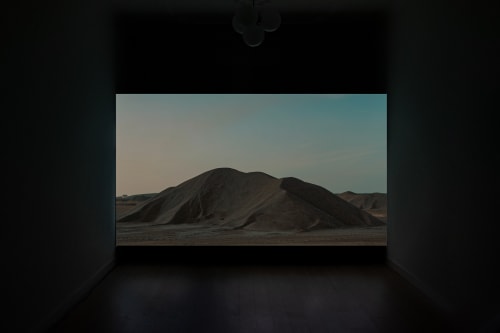Following her extensive artistic practice around the exploration of the material aspects of land and urban space, Lara Almarcegui presents two new works around the extraction of natural resources and the physicality of the land its constant transformation and arbitration.
In Rocks and materials of the Pyrenees mountains range (2021), Almarcegui enquires about the quantity and varieties of materials that constitute the Pyrenees mountain range, which came to be between eighty to twenty million years ago when the Iberic peninsula crashed into continental Europe. Where do the Pyrenees start and end? What is the desired degree of detail precision? How do these numeric facts influence our perception of the landscape? The result of these queries is a list of the weight of the rocks that conform the mountain range, calculated with the help of IGME (the Spanish Geological and Mining Institute). Not dissimilarly, the artist carried out a calculation of the amount of sand that lies beneath the Netherlands for her project Sand in the Netherlands, presented at Into Nature – Drenthe Biennial 2021, with the help of TNO (the National Dutch Geological Institute).
What possibilities emerge when the excavation of a quarry is stopped? The film Gravera (2021) visualises such speculation in a quarry in La Plana del Corb, an industrial complex situated close to the city of Lleida, Spain. For the last twenty-five years, many types of gravel have been extracted from this location. Once it has been selected and processed, the gravel is mostly used to make cement and asphalt. On February 19, 2021, the activity in the quarry was stopped and visitors were welcomed. Without the buzz from the machines, the dribble of the water streams, or the crunch and piling of the gravel, the quarry suddenly became a gritty landscape of rocky heaps and silent technology, a place stripped of noise for quiet contemplation. Overall, the film captures a stratigraphic imaginary dominated by the slow violence of the morphological transformation of the Earth in opposition to the temporary nature of the artificial constructions.
Lara Almarcegui has long been exploring gravel, a noncompact conglomerate of fragmented rock not yet sand extracted near cities for the production of concrete. For over twenty years, she has produced a series of geological records to examine contemporary transformation processes brought about by social, political, and economic change and to draw attention to mineral rights – which she often acquires to avoid extraction – and their legal protection. In doing so, Almarcegui has displayed the volume and mass of the materialities of exhibitions spaces such as the Spanish Pavilion in the 55th Venice Biennale, and art centres like Secession, Vienna; parallelly, she has created large-scale installations of gravel that mirror the average volume of extracted gravel, creating landmarks which both trace the built histories that surround us in the construction of our cities and tackle the urgency of exposing the view of the Earth as a limitless resource-making commodity.
In both of the works presented in this show the public is confronted with the huge volume and materiality of what rests underneath. In Almarcegui’s interventions, what at first glance might seem a solely quantitative study on materials, there lies a deeper reflection on the relation between the natural resources and their use for constructions, between geology and who owns it.
Project produced by Centre d’Art La Panera with the collaboration of Fundació Sorigué.


